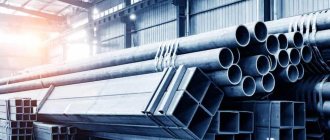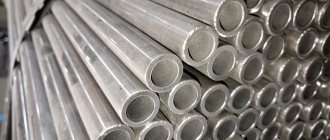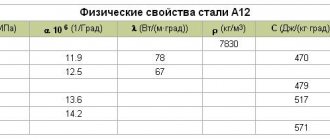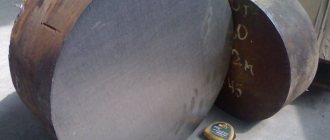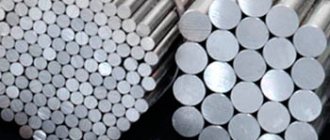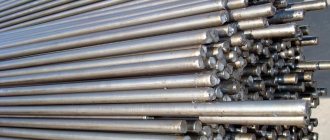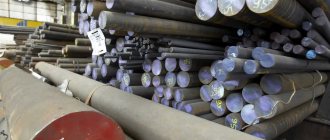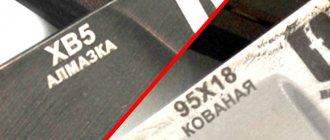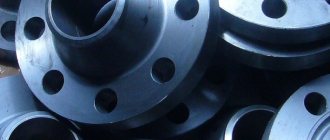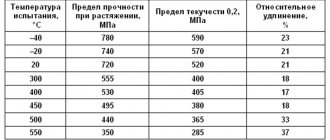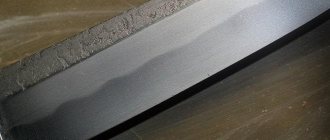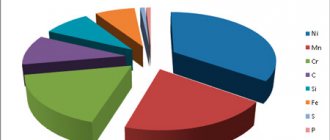Stainless steel has remained a popular material for many decades. Used in various industries: household, medical, heavy industry.
Given the popularity of this metal, people often look for affordable methods for determining stainless steel at home. In the article we will talk about them.
Features and Specifications
Before answering the question, it is advisable to understand why this metal is so popular. It's all about its properties and features:
- Resistance to environmental influences, including aggressive ones.
- Good wear resistance. With active use, the products last for more than ten years.
- Lack of response to sudden changes in ambient temperature.
- Lack of predisposition to the appearance and spread of corrosion.
- Not dangerous for people, animals, plants.
- Easy to care for and visually attractive.
Is steel a ferrous or non-ferrous metal?
It would seem a strange question: is steel a ferrous or non-ferrous metal ? Those who are a little familiar with the differences or classification of non-ferrous and ferrous metals will no doubt classify steel as ferrous metals and... they will be only partly right. The fact is that everything here depends on the grade of steel. Any steel (like cast iron - another type of ferrous metal) is a ferroalloy, that is, an alloy of iron, since it is this metal that is the constituent of both steels and cast irons. Another thing is that a lot depends on the percentage of iron and other elements in steel. If the iron content in the alloy is about or even more than 90%, then it is, of course, a ferrous metal. If it is less, that is, other elements account for 10% or more, then it is not necessarily black.
Thus, non-ferrous metals include a number of corrosion-resistant steels, which contain a fairly high nickel content (from 8%). Other steel grades are black. By the way, what types of steels exist in general? If we talk about the main types, these are steels for castings, structural, tool, heat-resistant, electrical, corrosion-resistant and some special ones (for example, rail, for shipbuilding, construction and others). And only corrosion-resistant or, as they are most often called, stainless steel, can be classified as non-ferrous metals.
Strictly speaking, such a division can be called commercial to a large extent, since even stainless steel is still a ferroalloy, since it contains more than 80% iron. However, from a commercial point of view, this is largely a non-ferrous metal, since such steel is valued much more expensive and its cost is calculated per kilogram, and not per ton, as is done for non-ferrous metals. By the way, the cost of 1 kg of stainless steel is quite comparable to the cost of a kilogram of lead (weight) or aluminum scrap (with the exception of electrical aluminum, aluminum profiles and ordinary lead scrap, which are slightly more expensive). That is why it is easier to classify such steel as a non-ferrous metal, taking into account the high nickel content in the alloy.
metallsday.ru
Types of stainless steel
There are several types of this material. In fact, it is an alloy with various impurities. The most common options are:
- Austenitic. Contains at least 20 percent chromium and 4.5 percent nickel.
- Duplex. A quarter of the composition is chromium. The amount of nickel has been reduced to 1.5%. Nitrogen impurities are also present.
- Ferritic. The percentage of chromium is up to 29.
- Martensitic. The composition contains only 13 chromium and 4% nickel.
There are also multi-component options. They contain a minimum of the main elements present in the compositions described above, but there are other impurities. Selected for specific purposes.
Physical properties of stainless steel
Stainless steel has received special priority among manufacturers not only due to its anti-corrosion properties, but also due to its very universal physical properties. The material is formed by mixing steel with admixtures of other metals.
The physical properties of the finished raw material directly depend on the admixture added to the steel. Depending on the content of a particular element, some types of stainless steel may succumb to corrosion after a certain service life. However, such compositions have their advantages, so relative fragility loses its importance.
Stainless steel has a number of physical properties that make it highly valuable in some industries. These include:
- The key property is anti-corrosion, as the name suggests. Stainless steel is not affected by alkalis, acids or other agents.
- Resistance to changes in the external environment. This steel withstands changes in temperature and air humidity, which allows it to serve for a long time.
- Stainless steel products are highly durable - physical stress does not deteriorate them as quickly as analogues made from other materials. Due to this, they remain operational for ten years or more.
- Heat resistance. Stainless steel is wear-resistant even under the influence of open fire and low temperatures.
- Appearance. Steel retains its external properties even after a long period of use, shines brightly and is easy to clean.
- Ease of processing.
Depending on the purpose of using stainless steel, a specific alloy is selected. Depending on it, the above properties can change both for the better and for the worse. For example, there are three main subtypes of stainless steel: corrosion-resistant, heat-resistant and heat-resistant.
Differences between ferrous metals and non-ferrous metals 2021
Ferrous metals vs non-ferrous metals
The quality of each material depends on its base. As modern technology develops, we often see new things being built, such as towering buildings and long bridges. In the past, these structures were built from fragile wood. But since people are quite dissatisfied, they are researching and developing new and stronger materials such as metals. Although metals are chemical elements found in nature, humans continue to improve their forms to make the most of them. Metals can be divided into two groups called ferrous metals and non-ferrous metals.
We all know that metals are flexible but strong. These shiny metals are very good conductors of heat and electricity, which makes them very important in today's living. But what exactly are the differences between ferrous and non-ferrous metals?
Ferrous metals contain iron. The word "black" has its roots in the Latin word "ferrum", which means "anything that contains iron." Specific examples of ferrous metals are: wrought iron, stainless steel and carbon steel. Because ferrous metals contain iron, they are magnetic. This property is the main difference between ferrous metals and non-ferrous metals. Ferrous metals are preferred in the construction of strong, durable iron fences and walls, gates and other materials made from ferrous alloys.
While ferrous metals are magnetic, non-ferrous metals are known for their lighter weight and even higher strength. Specific examples of non-ferrous metals are: brass, aluminum and copper. Since non-ferrous metals are also non-magnetic in nature, they have higher resistance to corrosion with elevated melting points. They are preferred in electronic applications. If you take a closer look at electrical wiring, it is made primarily of copper, which is a non-ferrous metal.
Earlier we said that ferrous metals are magnetic, but this depends on the amount of iron contained in these metals. The best example of this is stainless steel. This type of ferrous metal is not magnetic in nature because it undergoes a different process. To make it non-magnetic, it is soaked in nitric acid to get rid of its iron content, thus leaving only the nickel. Even if the stainless steel iron is specifically removed, it is still classified as a ferrous metal.
While non-ferrous metals are very resistant to corrosion, ferrous metals are not. This corrosion takes the form of rust, a reddish and brownish substance on ferrous metal surfaces. This is due to the presence of moisture in the air, which causes ferrous metals to rust.
Summary:
- There are two main categories of metals: ferrous metals and non-ferrous metals. Metals are generally strong, malleable, and ductile.
- The word "black" comes from the Latin
www.esdifferent.com
Distinctive characteristics of food grade stainless steel from technical grade
You can distinguish them by eye. The food version is characterized by a smooth surface with good processing quality. You can also carefully examine the item and try to determine the grade of stainless steel according to the marking supplied by the manufacturer:
- 08Х18Н10. It can be used in the food industry, but manufactured dishes should not be exposed to caustic soda.
- 08Х13. This brand is mainly used for the production of tableware.
- 20Х13-40Х13. They make dishes and sinks. It is distinguished by its plasticity, resistance to mechanical stress and temperature changes.
- 12X13. Most often used in the production of alcohol and wine.
- 08Х17. Used for making frying pans.
Differences between ferrous and non-ferrous metals. Chrome non-ferrous or ferrous metal
Is steel a ferrous or non-ferrous metal?
It would seem a strange question: is steel a ferrous or non-ferrous metal? Those who are a little familiar with the differences or classification of non-ferrous and ferrous metals will no doubt classify steel as ferrous metals and... they will be only partly right. The fact is that everything here depends on the grade of steel. Any steel (like cast iron - another type of ferrous metal) is a ferroalloy, that is, an alloy of iron, since it is this metal that is the constituent of both steels and cast irons. Another thing is that a lot depends on the percentage of iron and other elements in steel. If the iron content in the alloy is about or even more than 90%, then it is, of course, a ferrous metal. If it is less, that is, other elements account for 10% or more, then it is not necessarily black.
Thus, non-ferrous metals include a number of corrosion-resistant steels, which contain a fairly high nickel content (from 8%). Other steel grades are black. By the way, what types of steels exist in general? If we talk about the main types, these are steels for castings, structural, tool, heat-resistant, electrical, corrosion-resistant and some special ones (for example, rail, for shipbuilding, construction and others). And only corrosion-resistant or, as they are most often called, stainless steel, can be classified as non-ferrous metals.
Strictly speaking, such a division can be called commercial to a large extent, since even stainless steel is still a ferroalloy, since it contains more than 80% iron. However, from a commercial point of view, this is largely a non-ferrous metal, since such steel is valued much more expensive and its cost is calculated per kilogram, and not per ton, as is done for non-ferrous metals. By the way, the cost of 1 kg of stainless steel is quite comparable to the cost of a kilogram of lead (weight) or aluminum scrap (with the exception of electrical aluminum, aluminum profiles and ordinary lead scrap, which are slightly more expensive). That is why it is easier to classify such steel as a non-ferrous metal, taking into account the high nickel content in the alloy.
metallsday.ru
Where can I find a list of non-ferrous metals? Or does not black mean colored? Then which ones are black?
Classification of metals
All metals are conventionally divided into ferrous and non-ferrous. Ferrous metals usually have a dark gray color, high density (except for alkaline metals), a high melting point, and relatively high hardness. Some of them (iron, titanium, cobalt, manganese, zirconium, uranium, etc.) have polymorphism (allotropy). The most typical ferrous metal is iron.
Non-ferrous metals are red, yellow and white. They have high ductility, low hardness, and low melting point. It is known that tin has polymorphism. A typical representative is copper.
Ferrous metals include: #8722; ferrous metals iron, cobalt, nickel, manganese; #8722; refractory metals; have a melting point higher than that of iron, i.e. more than 15390C - titanium, vanadium, chromium, zirconium, niobium, molybdenum, tungsten, technetium, hafnium, rhenium; #8722; uranium metals (actinides) thorium, actinium, uranium, neptunium, plutonium, etc. (from 89 to 103 elements); #8722; rare earth metals (from 57-71 elements), lanthanum, cerium, niodymium, etc. ; #8722; alkaline earth metals - lithium, sodium, calcium, potassium, rubidium, strontium, cesium, barium, francium, rhodium, scandium.
Non-ferrous metals include: #8722; light beryllium, magnesium, aluminum; #8722; noble metals - ruthenium, radium, palladium, osmium, iridium, platinum, gold, silver and semi-precious copper; #8722; low-melting metals zinc, cadmium, mercury, gallium, indium, thallium, germanium, tin, lead, arsenic, antimony, bismuth.
Metals and alloys include substances produced by powder metallurgy.
Classification of non-metallic materials: #8722; organic and inorganic polymers; #8722; plastics; #8722; composite materials; #8722; rubbers and rubbers; #8722; adhesives and sealants; #8722; paint and varnish coatings; #8722; graphite; #8722; glass; #8722; ceramics.
info-4all.ru
Differences between ferrous and non-ferrous metals | AlpPlus
This is one of the most frequently asked questions. So what is the difference between ferrous and non-ferrous metal? The answer is actually quite simple.
Ferrous metals and alloys contain iron; non-ferrous metals no. But it's not so easy to tell if you just look at a random piece of metal. Fortunately, there are several other factors that can be used to determine affiliation.
Characteristics of ferrous metals
Ferrous metals include mild steel, carbon steel, stainless steel, cast iron and wrought iron. These metals are used primarily for their tensile strength, which helps hold up the tallest skyscrapers and longest bridges in the world. You can also find many ferrous metals in home construction, industrial containers, large-scale piping, automobiles, most tools and fasteners used throughout the home, and so on.
While wrought iron resists oxidation, and stainless steel, which is protected by its high chromium content, otherwise, if you see rust, it's ferrous metals.
Most ferrous metals have good magnetic properties, which makes them very useful in creating large motors and electrical appliances.
Most importantly, ferrous metals are easily processed without losing their properties.
Characteristics of non-ferrous metals
Non-ferrous metals include aluminum, brass, copper, nickel, tin, lead, and zinc, as well as precious metals such as gold and silver. While non-ferrous metals can provide strength, they are primarily used where their differences from ferrous metals can provide an advantage.
For example, non-ferrous metals are much more malleable than ferrous metals. Non-ferrous metals are also
www.consei.ru
